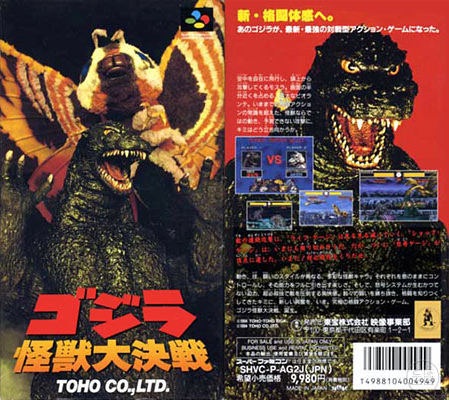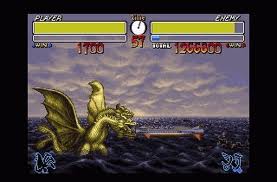Godzilla: Great Monster Battle
| Alfa System Godzilla games | |||||||
|
|
| |||||
| |||||||||||||||||||||||||||||||||||||||||||||||
Godzilla: Great Monster Battle (ゴジラ怪獣大決戦 Gojira Kaijū Daikessen) is a 2-D fighting game developed by Alfa System and published by Toho for the Super Famicom, released on December 9, 1994. It is the sequel to Godzilla: Battle Legends. An American version of the game called Godzilla: Destroy All Monsters was planned to be released in April 1995, but never was.
Gameplay
Normal Game
In the normal single player game, players are able to choose from Godzilla himself, Anguirus, King Ghidorah, Gigan, Megalon, Mechagodzilla, Biollante and Mothra. After selecting a monster, the player is taken to a map of Japan and must select an opponent to battle. Battles take place in the familiar 2D fighting screen popularized by Street Fighter 2, though the game plays more akin to the SNES Dragon Ball Z fighting games. Each round has a time period of sixty seconds during which each monster fights with a variety of attacks to wear their opponent's energy bar down and win the round. At the end of the round, the player's score is tallied up based on time, energy, and the level of their opponent. Once every enemy monster has been defeated, the player enters the eighth, final round and must face the Heisei Mechagodzilla or the Gotengo. Upon the defeat of one of those opponents, the credits roll and the game ends.
Each monster has a variety of standard and unique, special attacks and the ability to block. Standard attacks include light and heavy physical attacks (punch, kick, etc.) and varying degrees of energy-based attacks, a dash attack and a grab attack. Each monster also appears to have the ability to stun the opponent with a loud roar. As a succession of hits is landed, the monster will glow red, allowing a powerful super move to be unleashed. Monsters are able to use their projectile attacks to block oncoming projectiles, similar to Street Fighter 2, and sometimes the two clash in a brief test-of-strength encounter.
VS Game
The game supports the standard two player versus mode, the only difference being the player's ability to select to play as the Heisei Mechagodzilla, Super Mechagodzilla, and the Gotengo, and to choose their own battleground.
Monsters
Playable
- Godzilla, King of the Monsters
- Anguirus, the Fierce Dragon
- King Ghidorah, the Space Super Monster
- Gigan, the Cyborg Monster
- Megalon, the Insect Monster
- Mechagodzilla, the Robot Monster
- Biollante, the Bio Monster
- Mothra, the Giant Moth Monster
- Mechagodzilla, the G-Force Anti-Godzilla Weapon (only playable in VS Game)
- Super Mechagodzilla, the G-Force Anti-Godzilla Weapon (only playable in VS Game)
- Gotengo, the All-Purpose Warship (only playable in VS Game)
Unplayable
- Garuda (can attach to or detach from Super Mechagodzilla)
- Battra (appears in Mothra's special combo move)
- Manda (appears on the Gotengo's onscreen icon)
- Pteranodon Robot (appears in Super Mechagodzilla's victory animation)
Stages
There are nine stages in the game, each taken directly from a film and serving as the home stage for a monster. Godzilla does not have a home stage and will appear on the home stage of the player's monster, while the Heisei Mechagodzilla and Super Mechagodzilla share the same stage.
- Osaka Castle Grounds (Godzilla Raids Again - Anguirus)
- Fuji Five Lakes (Invasion of Astro-Monster - King Ghidorah)
- World Children's Land (Godzilla vs. Gigan - Gigan)
- Outskirts Of Tokyo (Godzilla vs. Megalon - Megalon)
- Yokosuka (Terror of Mechagodzilla - Mechagodzilla)
- Wakasa Bay (Godzilla vs. Biollante - Biollante)
- Minato Mirai 21 (Godzilla vs. Mothra - Mothra)
- Makuhari Bay Area (Godzilla vs. Mechagodzilla II - Mechagodzilla [Heisei] and Super Mechagodzilla)
- Tokyo Bay (Atragon - Gotengo)
Gallery
King Ghidorah's palette swaps
Videos
- Main article: Godzilla: Great Monster Battle/Videos.
Trivia
- Despite not being playable in this game after being playable in Godzilla: Battle Legends, Battra appears as a special move used by Mothra, replicating a scene from Godzilla vs. Mothra.
- The splash screens before each battle display the monsters' names in the font used in posters from films featuring them. For this reason, the Gotengo is referred to as the "Undersea Warship" (海底軍艦 Kaitei Gunkan) in the pre-battle splash screen, with the name displayed in the font used on the poster for Atragon.
- The Showa and Heisei Mechagodzillas are both only referred to as "メカゴジラ" (Mekagojira) in this game, the only difference being the font in which their names are displayed and the subtitles displayed above them. The Showa Mechagodzilla's name is written in the same font it appeared in on posters for Godzilla vs. Mechagodzilla, while the Heisei Mechagodzilla's name is written in the font used on posters for Godzilla vs. Mechagodzilla II. The Showa Mechagodzilla is given the subtitle "Robot Monster," while the Heisei incarnation is given the subtitle "G-Force Anti-Godzilla Weapon."
- The May 1995 issue of the magazine Nintendo Power mentioned an American release of this game, titled Godzilla: Destroy All Monsters, and claimed that it was released in April, though it never was. The game was never mentioned in the magazine again, and never saw an American release.
- While both the Showa and Heisei incarnations of King Ghidorah were playable in the previous game, only the Showa iteration is playable in Godzilla: Great Monster Battle. This is a rare instance of only the Showa incarnation of the character appearing in a video game following the release of Godzilla vs. King Ghidorah, as the vast majority of video games since have used the Heisei version instead.
Comments
Showing 13 comments. When commenting, please remain respectful of other users, stay on topic, and avoid role-playing and excessive punctuation. Comments which violate these guidelines may be removed by administrators.








